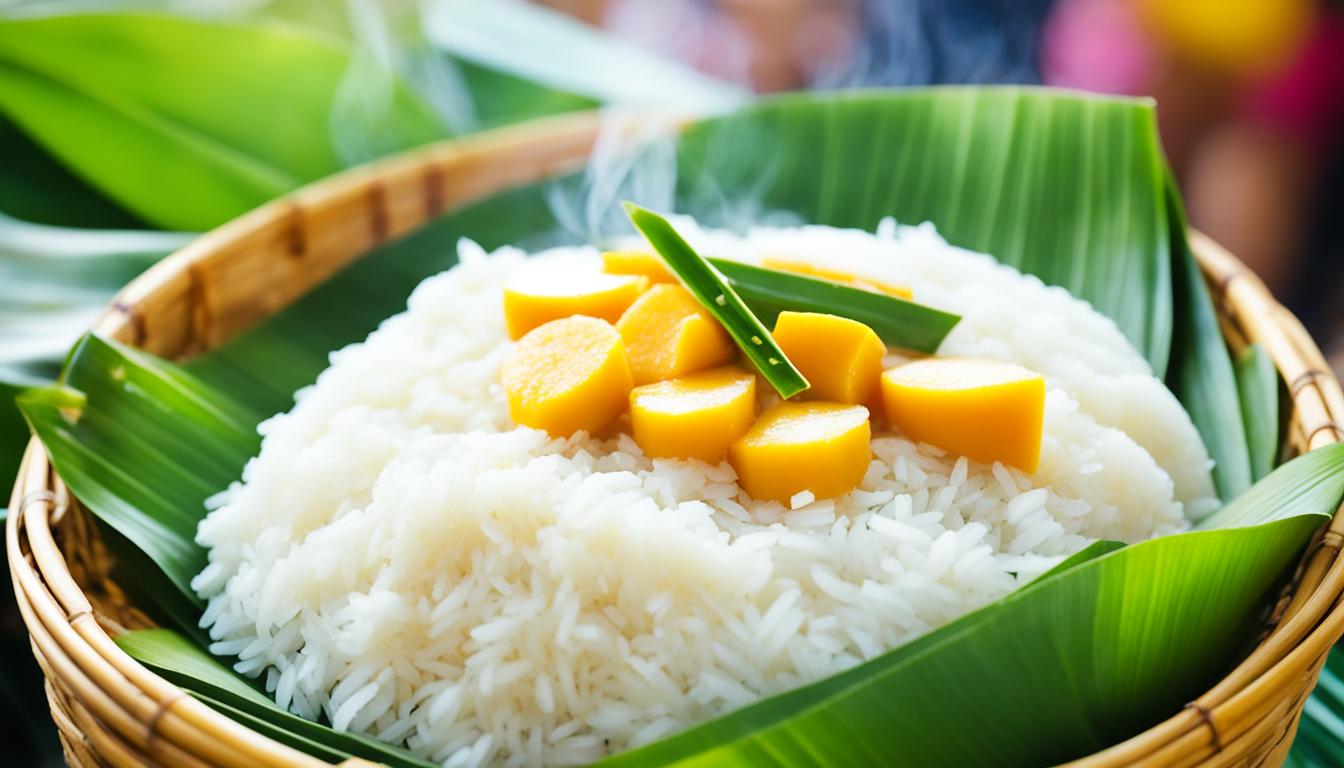Have you ever wondered how to make the perfect Thai sticky rice, also known as Khao Niao?
This cherished traditional dessert in Thai cuisine may seem intimidating, but fear not! With the right techniques, you can easily master the art of creating this delicious treat.
In this article, we will guide you through every step of the process, from choosing the right type of rice to cooking it to perfection. So, get ready to indulge in the sticky, sweet, and oh-so-satisfying world of Thai sticky rice!
But first, let’s uncover the secrets of picking the right type of rice to achieve that irresistible texture and taste. Are you ready to dive in?
How to Pick the Right Type of Rice
The type of rice used in Thai sticky rice is crucial for achieving the desired texture and taste. It is important to use glutinous rice, also known as sweet rice or sticky rice, for the best results. Not all types of sticky rice are the same, and it is recommended to look for rice that is specifically labeled as “sweet rice” or “glutinous rice” from Thailand. The grains of this rice variety are bright opaque white when raw and turn off-white and shiny when cooked. It has a high level of amylopectin, a type of starch molecule that gives sticky rice its characteristic stickiness.
When selecting glutinous rice, look for a product that is imported from Thailand, as it ensures the authentic flavor and quality you’re seeking in your glutinous rice dishes. Thai glutinous rice is widely recognized for its superior taste and stickiness, making it the ideal choice for creating delicious sweet sticky rice desserts and other Thai cuisine recipes.
With its unique texture and flavor, glutinous rice opens up a world of culinary possibilities. From savory dishes like Thai sticky rice with grilled meats to sweet delights such as mango sticky rice, this versatile grain can elevate any meal. It’s worth noting that although glutinous rice is often associated with desserts like sweet sticky rice, it can also be used in a wide range of savory dishes, adding depth and richness to your Thai cuisine recipes.
Next, we’ll explore the proper technique for cooking sticky rice, ensuring that you achieve perfectly tender yet sticky grains that are the essence of this beloved Thai dessert.
The Proper Technique for Cooking Sticky Rice
Cooking sticky rice requires a specific technique to ensure the grains are tender and sticky, but still retain their shape. Here’s a step-by-step tutorial on how to make delicious Thai sticky rice:
1. Soak the Rice
The first step in cooking sticky rice is to soak it in water for at least 4 hours or overnight. This allows the grains to absorb moisture and cook evenly. Make sure to use enough water to fully submerge the rice.
2. Drain and Rinse the Rice
After soaking, drain the rice using a fine-mesh sieve or colander. Rinse it thoroughly with cold water to remove any excess starch. This helps prevent the rice from becoming too sticky or clumpy.
3. Steam the Rice
Next, transfer the rinsed rice to a steamer basket or a traditional Thai sticky rice steamer. Arrange the rice in an even layer to ensure even cooking. If using a steamer basket, place it over a pot of boiling water. Steam the rice for about 20 minutes, or until it becomes soft and sticky.
4. Flip the Rice
About halfway through the cooking process, it’s important to flip the rice to ensure even heat distribution. Gently turn the rice over using a spatula or chopsticks to prevent uneven cooking and ensure that all the grains are evenly steamed.
5. Let the Rice Cool
Once the rice is cooked, remove it from the steamer and let it cool slightly before serving. This allows the rice to set and become even stickier. It’s best to serve the sticky rice while it’s still warm and freshly steamed.
Now that you know the proper technique for cooking sticky rice, you can confidently prepare delicious Thai sticky rice at home. Enjoy it as a sweet dessert, paired with fresh mangoes for a classic Thai treat, or as a versatile side dish in your favorite Asian-inspired recipes.
Serving and Enjoying Sticky Rice Traditionally
Sticky rice is a beloved ingredient in Thai cuisine that is served and enjoyed in various ways. One of the most popular ways to enjoy sticky rice is by pairing it with fresh mangoes to create the delectable dessert known as mango sticky rice. In this delightful dessert, the sticky rice is served alongside sliced ripe mangoes and topped with a luscious drizzle of coconut sauce.
In addition to being a delicious dessert, sticky rice can also be enjoyed as a side dish with grilled or roasted meats, and fish. Its unique texture and flavor make it a versatile ingredient that pairs well with a wide range of flavors and textures. It adds a delightful touch to any meal, bringing a satisfying and comforting element to the dining experience.
When it comes to serving sticky rice, there are a few traditional practices that add to the overall enjoyment of this delightful Thai dessert. Diners often mold the sticky rice into small balls, making it easy to pick up and savor. Alternatively, some people prefer to use their fingers to scoop up the rice, relishing each mouthful. These traditional serving methods not only enhance the tactile experience but also provide a glimpse into the rich cultural heritage of Thailand.
